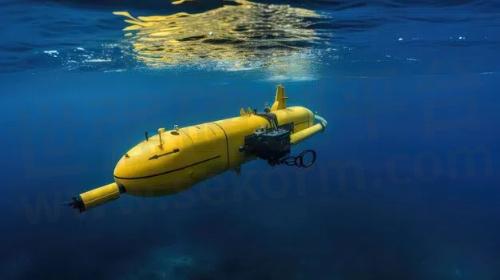AUV vs. UUV: What’s the Difference?




Underwater exploration, research, and military operations often require the use of specialized vehicles that can operate autonomously or be remotely controlled. Two key types of underwater vehicles are AUVs (Autonomous Underwater Vehicles) and UUVs (Unmanned Underwater Vehicles). Though they share similarities, these systems have distinct roles, capabilities, and applications. In this article, we’ll explore what these terms mean, their differences, and the advantages and disadvantages of each type of vehicle.
What Does an AUV Stand For?
An AUV stands for Autonomous Underwater Vehicle. As the name implies, AUVs are designed to operate underwater without direct human control. These vehicles are pre-programmed to follow specific paths or complete predefined missions without real-time guidance. They use various sensors to navigate, gather data, and perform tasks in oceans, lakes, and other underwater environments.
Fully autonomous operations carry power onboard. Power enables propellers or thrusters to move an AUV through the water and is necessary to operate sensors on the AUV. Most AUVs use specialized batteries, although some AUVs have used Fuel Cells or rechargeable solar power. Certain AUVs, such as gliders, minimize energy demands by allowing gravity and buoyancy to propel them.

What Is the Meaning of a UUV?
UUV stands for Unmanned Underwater Vehicle, which is a broader category that encompasses any underwater vehicle that does not require a human onboard. UUVs can be either autonomous (AUVs) or remotely operated (ROVs), meaning that a UUV might be controlled by an operator from a remote location, or it might be fully autonomous like an AUV.
UUVs are versatile and are deployed for various underwater tasks, ranging from exploration to defense operations, and can be classified into several subcategories, including AUVs and ROVs (Remotely Operated Vehicles).

What Is the Difference Between an AUV and a UUV?
The main difference between an AUV and a UUV lies in the scope and control of these systems:
AUVs are a specific type of UUV that are fully autonomous. Once launched, they follow a pre-programmed route or mission without human intervention.
UUVs, on the other hand, refer to any unmanned vehicle operating underwater, and this includes both AUVs and ROVs. ROVs are typically tethered and controlled remotely by operators, offering real-time interaction with the vehicle.
In short, all AUVs are UUVs, but not all UUVs are AUVs. The critical distinction is that AUVs function independently, while UUVs can either be autonomous or remotely operated.
Advantages and Disadvantages of AUVsAdvantages
●Autonomous Operation: AUVs can operate without human intervention, making them ideal for long-duration missions or in hazardous environments where human involvement is not feasible.
●Efficiency in Data Collection: AUVs are equipped with advanced sensors and navigation systems, allowing them to collect high-quality data in a more efficient manner, such as during marine surveys or seafloor mapping.
●Cost-Effective: Once deployed, AUVs can reduce operational costs by eliminating the need for constant human oversight, as opposed to manned submarines or remotely operated systems.
●Access to Hard-to-Reach Areas: AUVs can navigate into areas where tethered vehicles or human divers cannot, such as deep ocean zones or under ice-covered waters.
Disadvantages
●Limited Real-Time Control: Once deployed, AUVs follow their programmed mission and cannot be easily redirected or controlled in real-time unless they are recovered and reprogrammed.
●Risk of Mission Failure: Autonomous systems can encounter unexpected obstacles, leading to potential mission failures if they are unable to adapt or avoid these hazards.
●Energy Constraints: AUVs are typically battery-powered, and longer missions require larger energy capacities, which can limit their operational range and mission duration.
Advantages and Disadvantages of UUVsAdvantages
●Versatility: Since UUVs include both AUVs and ROVs, they can be used for a wider range of applications, including tasks that require direct human control (with ROVs) or complete autonomy (with AUVs).
●Human Safety: UUVs can perform dangerous tasks, such as inspecting underwater pipelines, conducting military surveillance, or searching for mines, without risking human lives.
●Customizability: UUVs can be tailored for specific missions, whether it’s real-time manipulation via an ROV or autonomous mapping with an AUV.
Disadvantages
●Dependence on External Control (for ROVs): Remotely operated UUVs like ROVs require a tether or wireless communication with an operator, limiting their range and increasing operational complexity.
●High Operational Costs: UUV operations, especially those involving ROVs, can be expensive due to the need for specialized equipment, personnel, and support vessels.
●Limited Autonomy (for ROVs): Unlike AUVs, ROVs require constant human control, which can slow down missions and increase labor costs.
Batteries Used in AUVs and UUVs
Powering AUVs and UUVs requires advanced battery technology to ensure operational longevity and reliability. The primary types of batteries used in these vehicles include:
●Lithium-ion Batteries: These are the most common type of batteries used in AUVs and UUVs due to their high energy density, long cycle life, and relatively lightweight nature. Lithium-ion batteries are especially favored for extended missions.
●Silver Zinc Batteries: Silver zinc batteries are often used in underwater vehicles due to their ability to provide high power outputs and energy density. However, they are generally more expensive and have a shorter cycle life compared to lithium-ion batteries.
●Aluminum-Oxygen or Aluminum-Seawater Batteries: These are emerging as potential solutions for longer-duration missions due to their energy density and reliance on seawater as a reactant, making them highly efficient for deep-sea operations.
●Fuel Cells: Fuel cells are gaining interest in the underwater vehicle industry, offering long-duration energy solutions for missions that require extended autonomy. These systems generate electricity through chemical reactions, allowing vehicles to operate longer than traditional batteries.
Conclusion
In conclusion, AUVs are specialized underwater vehicles that operate autonomously, whereas UUVs represent a broader category that includes both autonomous and remotely operated vehicles. Both systems offer unique advantages and disadvantages, from operational efficiency to energy limitations, and their choice of power sources reflects their specific mission requirements. As a global leading lipo battery manufacturer, Grepow offers high-energy-density pouch lithium-ion batteries and high-capacity lipo batteries that perfectly meet the needs of humanoid robots.
- |
- +1 赞 0
- 收藏
- 评论 0
本文由莫子若转载自Grepow Official Website,原文标题为:AUV vs. UUV: What’s the Difference?,本站所有转载文章系出于传递更多信息之目的,且明确注明来源,不希望被转载的媒体或个人可与我们联系,我们将立即进行删除处理。
相关推荐
What is a High Energy Density Battery?
In this article, we explore what makes a battery high-energy, identify the current leaders in the field, and discuss the science behind their high performance, focusing on the materials and technologies that enable such impressive energy storage capabilities.
What is the Impact of Long Coldness on Agriculture Spraying UAVs Batteries and How to Deal with it
Agricultural drones are not only used for spraying and applying medicine, but also for spreading fertilizer, seeds, and feeds to meet the diversified needs of farmers and improve production efficiency.
NMC Battery vs. LCO Battery: What’s the Difference?
When it comes to lithium-ion batteries, two of the most commonly discussed chemistries are NMC (Nickel Manganese Cobalt) and LCO (Lithium Cobalt Oxide). Both are widely used in a variety of applications, from electric vehicles to consumer electronics, but they differ significantly in terms of chemical composition, energy density, cycle life, and cost. Understanding the key differences between NMC and LCO batteries is essential for choosing the right battery for specific applications, whether you‘re powering a smartphone or an electric vehicle.
Recycling and Regeneration of Lithium Batteries
Under the pursuit of economic and environmental protection, the production and demand of lithium batteries have grown in recent years. Decommissioned lithium batteries are known as high-grade mines, coupled with the price and mining of raw materials, so the recycling value is obvious.
Grepow Rechargeable Li-lon Button Cells Solutions for High-tech Applications
Grepow has provided dedicated energy solutions for high-tech applications in bluetooth headsets for smart phones, notebook bridging function, body shaping and training sensors, medical and health care equipment, wireless sensor and network infrastructure and many more. For all these applications, Grepow offers a range of Lithium-Ion button cells and battery assemblies in diameters from 7.8 - 24 mm with 6.5 mAh to 210 mAh.
How to Solve the Imbalance between Li-ion Battery Pack Cells and the usual maintenance of Lithium-ion batteries
Grepow tells how to Solve the Imbalance between Li-ion Battery Pack Cells and the usual maintenance of Lithium-ion batteries? and then Grepow shares with you some of the usual maintenance of lithium-ion batteries
Grepow Battery will exhibit at 2022 Summer Asia Smart Wearable Exhibition
The bi-annual Asia Smart Wearable Exhibition (ASWE) will be held from July 18 to July 20 at Shenzhen International Convention and Exhibition Center. Grepow will bring its smart wear accessories shaped lithium-ion batteries and button batteries present, booth number: C24 in Hall 4.
Can Lipo Battery Cells Be Shipped by Air?
With the widespread use of electronic products, batteries nowadays have become household items that we can see everywhere. The most commonly encountered type of battery is the lithium-ion battery.
How Are Smart Rings Powered?
Smart rings are powered by efficient, rechargeable batteries and designed with energy-saving technologies, they provide a balance of performance and convenience. As a global leading lipo battery manufacturer, Grepow can provide extremely narrow smart ring batteries, as thin as 1.4mm and as narrow as 4.5mm, to meet the design requirements of various innovative smart rings.
What is the packaging technology of soft pack Li Ion battery?
Soft pack lithium-ion batteries are always found in consumer electronics, as UAV/drone batteries, and the high-performance batteries of RCs, for military, and automotive industries. This article talks about the packaging technology of soft pack Li Ion battery.
Prescription vs OTC Hearing Aids: What‘s the Difference?
If you value convenience, long-term savings, and eco-friendliness, rechargeable hearing aids could be the better choice. However, if you prefer a lower upfront cost and the simplicity of changing batteries without worrying about charging, disposable battery models might be more suitable. Both options are available in prescription and OTC hearing aids, so you can make a choice that best suits your lifestyle and hearing needs.
What Types of Batteries Are Used in Pet GPS Trackers?
Pet GPS trackers have become essential tools for pet owners who want to ensure the safety and well-being of their furry companions. These devices rely on a steady power source to function effectively, and the type of battery used can significantly impact their performance, size, and convenience. Different trackers utilize various battery types, each with its own advantages and drawbacks. Understanding the types of batteries used in pet GPS trackers is crucial for making an informed decision that aligns with your pet’s needs and your lifestyle.
Steel-Shell vs. Soft Pack Coin Cell Batteries for TWS Earbuds: Which is Better ?
The mainstream TWs headset battery types currently on the market are steel-cased button batteries and soft pack button batteries. The two have differences in the amount of charge, shape, and many other aspects, so TWS headphones with Steel-Shell or Soft Pack Coin Cell Batteries cells are good.
NMC vs NCA Battery Cell: What’s the Difference?
Choosing between NMC and NCA battery cells depends on the specific requirements of the application. NMC cells offer a versatile and cost-effective solution with balanced energy and power characteristics, making them ideal for a wide range of uses from EVs to power tools. On the other hand, NCA cells provide higher energy density and longer cycle life, making them suitable for high-performance EVs, consumer electronics, and aerospace applications.
What Battery Is Used in Humanoid Robots?
In this article, we will explore how humanoid robots are powered, the types of batteries they use, the development trends in this technology, and the challenges that developers face in improving humanoid robot batteries.
电子商城
品牌:至诚微
品类:Highly integrated synchronous boost charger IC
价格:¥1.9200
现货: 10,000
品牌:至诚微
品类:Highly integrated synchronous boost charger IC
价格:¥1.2941
现货: 10,000
服务
可自由定制电池形状,锂离子聚合物/磷酸铁锂成分,放电倍率Max. 50C (持续放电倍率) / 150C (脉冲放电倍率),充电倍率:Max. 5,厚度可达0.5mm。
最小起订量: 5000 提交需求>







































































































































































































登录 | 立即注册
提交评论